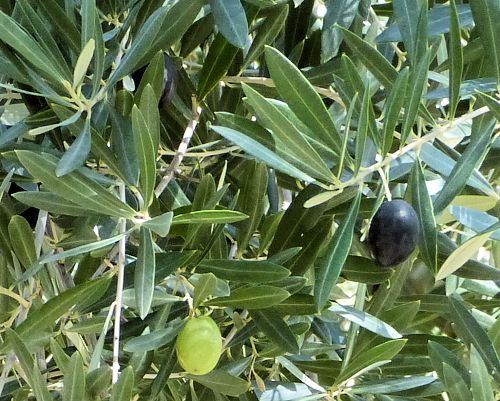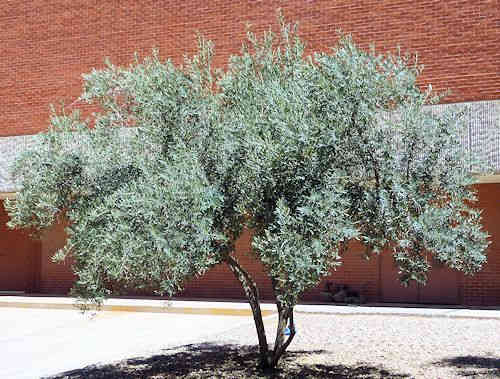Growing Olives:
Olea europaea
Back to Fruit, Berries and Nuts
Botanical Overview
A member of the Olive family (Oleaceae), the Olea genus contains about 40 species, the most important being the commercially grown olive. Olea europaea has hundreds of cultivars and is grown around the world.
Description
Form:
A single or multi-trunked large shrub or small tree.
Lifespan:
300-600 years.
Leaf retention:
Evergreen.
Growth rate:
Slow to moderate.
Mature Size:
30' (9m) high and wide.
Flowers:
Small, clustered, creamy-white. The pollen causes severe allergies. Fruitless varieties
produce less pollen and little or no fruit.
Bloom:
Spring. Olive trees tend toward alternate blooming, producing fruit heavily one year and
lightly, or not at all, the next.
Self-fruitful:
Depends on cultivar. Olives are wind pollinated and all trees do better with a second
cultivar. Bees are seldom involved.
Years before fruiting:
2-4.
Fruit:
A fleshy, oil-bearing, bitter fruit, called an olive, with a thin skin and a single hard pit
containing a seed. Green table olives are picked when green and unripe. Dark colored olives
are picked when ripe and can be many colors, including red, purple and black. The taste of
table olives and olive oil is determined as much by the processing operation after harvest as
by the cultivar.
Months for fruit to ripen:
6-8. Olives are mature when they reach their full color. At this time they are ready to drop
from the tree. Depending on the cultivar, olives are picked unripe and green for eating or
fully ripe for eating or oil.
Storage after harvest:
Olives must be processed quickly after harvest, into oil or table olives, to maintain
quality. Table olives must be cured, a process that removes bitterness, before becoming
palatable.
Curing methods are Brine Curing: fermenting in salt water for up to one year;
Water Curing: each olive is cracked and soaked in daily changes of water for a week or more, then placed in a finish brine with salt and other flavoring elements;
Dry Curing: packing in salt for a month or more;
Lye Curing: using 100% sodium hydroxide with no additives, a method that takes a few days and makes the olives relatively sweet; and
Sun/Air Curing: when the fruit is left on the tree to cure, or picked and left to bask in the sun.
Once cured, olives are sometimes pitted and dried like raisins.
While traditional curing methods often add vinegar to make the olives sour, sugar can be used instead as a sweetener.
Modern olive oil extraction is a complex process that involves crushing the clean olives (and their pits) to a fine paste, mixing (malaxing) the paste for 20-45 minutes to allow tiny oil droplets to combine into larger ones, adding water, and using centrifuges to separate oil from paste. Quality is maintained by not exposing the olives to temperatures over 80°F (27°C), light or oxygen during the process and by thorough cleaning of the equipment between each step.
Curing methods are Brine Curing: fermenting in salt water for up to one year;
Water Curing: each olive is cracked and soaked in daily changes of water for a week or more, then placed in a finish brine with salt and other flavoring elements;
Dry Curing: packing in salt for a month or more;
Lye Curing: using 100% sodium hydroxide with no additives, a method that takes a few days and makes the olives relatively sweet; and
Sun/Air Curing: when the fruit is left on the tree to cure, or picked and left to bask in the sun.
Once cured, olives are sometimes pitted and dried like raisins.
While traditional curing methods often add vinegar to make the olives sour, sugar can be used instead as a sweetener.
Modern olive oil extraction is a complex process that involves crushing the clean olives (and their pits) to a fine paste, mixing (malaxing) the paste for 20-45 minutes to allow tiny oil droplets to combine into larger ones, adding water, and using centrifuges to separate oil from paste. Quality is maintained by not exposing the olives to temperatures over 80°F (27°C), light or oxygen during the process and by thorough cleaning of the equipment between each step.
Leaves:
Lance-shaped, narrow, to 3" (7.5cm) long, thick, gray-green on top, lighter underneath.
This tree provides dense shade.
Stems:
No thorns. The trunk is gray, bumpy, contorted, and gnarled.
Roots:
The extensive root system includes surface roots that can heave walkways and trip pedestrians.
Cultivars of Note for hot desert regions:
'Arbequina' From Spain, high oil content with a mild
oil flavor, self-fruitful, very slow growing to 10-15' (3-4.5m) high.
Hardy to 25°F (-3.9°C).
'Manzanillo' / 'Manzanilla' From Spain, a green table
olive, high pulp to pit ratio, buttery texture, pit separates easily, self-fruitful, grows
8-10' (2.4-3m) high. Hardy to 15°F (-9.4°C).
'Mission' Recognized as an American cultivar that
evolved from the Cornicabra olive brought over from Spain by missionaries. Self-fruitful,
often picked ripe and dry salt cured to produce black olives.
Hardy to 15°F (-9.4°C.
'Swan Hill' A fruitless olive tree with little to no
pollen used as an ornamental. Hardy to 15°F (-9.4°C.
Wildlife:
The fruit attracts birds. Rabbits may eat the bark, especially on young trees, and greatly harm
the tree.
Toxic / Danger:
Olive fruit are very bitter, and must be cured to be palatable. However, no part of the olive
tree is actually poisonous to animals or humans. The abundant pollen can be a problem for
sensitive individuals.
Origin: Eastern Mediterranean. Commercial cultivation
began at least 7000 years ago.


Cultivation and Uses
USDA hardiness zones:
9-11 for most fruit-bearing trees. 8-11 for fruitless cultivars.
Chill hours:
200-300. For olives, temperatures above 32°F (0°C) and below 55°F (12.8°C)
accumulate chill hours in winter.
Heat tolerant:
Yes.
Drought tolerant:
Yes.
Sun:
Full sun.
Planting:
Locate these trees in full sun and in well draining soil.
They should be spaced 25-30' (7.5-9m) apart.
Soil:
Well draining, dry, low organic content, with a pH range of 5.6-8.5 (acidic to alkaline).
This plant is salt tolerant.
Fertilize:
Olive trees are better adapted to poor soil than most other fruit trees and seldom suffer
nutritional deficiencies. In residential settings, fertilization is unnecessary, even for a
good fruit crop. Water and weeding are the most important aspects of olive tree care.
Water once established:
Deep water once or twice a month in warm months.
Avoid locations near frequently irrigated lawns or plants. Some fruiting olive cultivars do
poorly in regions with summer rains.
Mulch:
No mulch is necessary.
Prune:
In spring, in dry weather, after flowers appear, prune to shape. Fruit is produced at the
tips of the previous year's growth. Remove excess small fruit within 3 weeks of flowering so
that two to three fruit are left per foot (30cm) of branch. This results in larger fruit.
Also remove any suckers growing from the roots.
Litter:
High due to fruit drop. The fruit stain concrete. Spraying the open flowers and leaves with
a growth regulator during flowering will stop fruit production. Be sure to spray all flowers
and leaves thoroughly. Allow the sprayed surfaces to dry for four to five hours, and deep
water the tree for several hours so that it will have sufficient moisture to distribute the
growth regulator throughout its tissues.
Propagation:
Cuttings grafted onto hardy rootstock. Cuttings taken just after fruit set and rooted in a
sand and peat mix. Seed do not grow true to the parent but can be used ornamentally.
Uses:
Ornamental, fruit production.
Comments
Some municipalities allow only sterile, fruitless cultivars in order to reduce
pollen levels. Hundreds of fruit-bearing cultivars are available. The picture at bottom shows
the fruitless cultivar 'Swan Hill'.
The term "Cold Pressed" means that no heat was added during oil extraction, and
that a press was used to crush the olives to a paste before oil extraction. Centrifuges
instead of presses are used to extract the oil except in small operations.
The term "Extra Virgin" refers to oil extracted by old fashioned olive presses
during the first pressing, and is no longer important. It is now used to indicate that the oil
has a significant amount of olive flavor compounds. Olive oil used for cooking has few
olive flavor compounds.
Do you have additional information or a different experience for these plants that you would like to share? Email info@GardenOracle.com. All contributions are welcome and appreciated.
Do you have additional information or a different experience for these plants that you would like to share? Email info@GardenOracle.com. All contributions are welcome and appreciated.
Latest update: May, 2025
© 2008-2025 by GardenOracle.com

